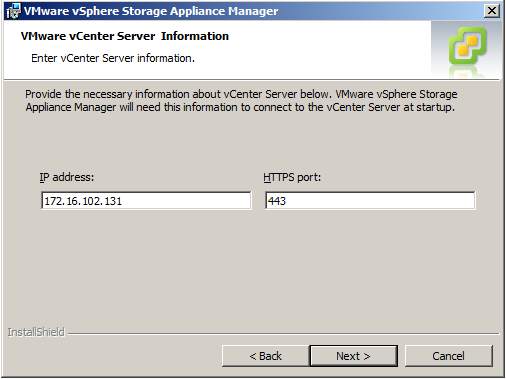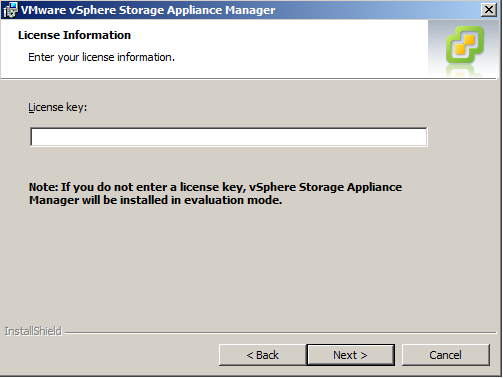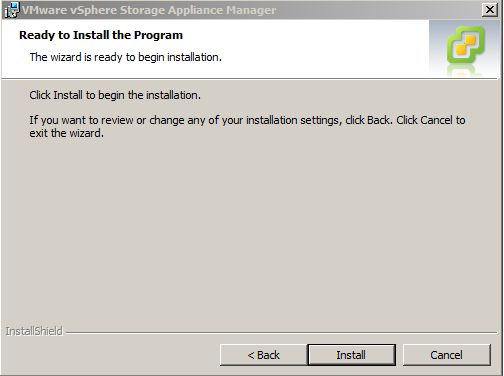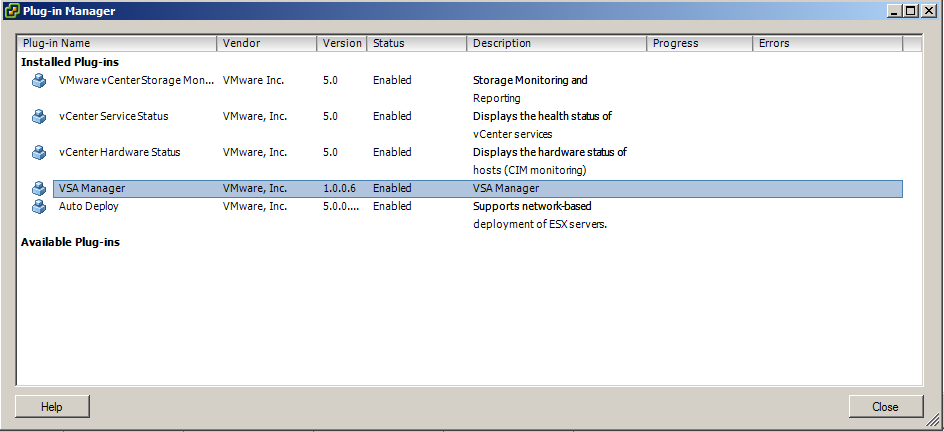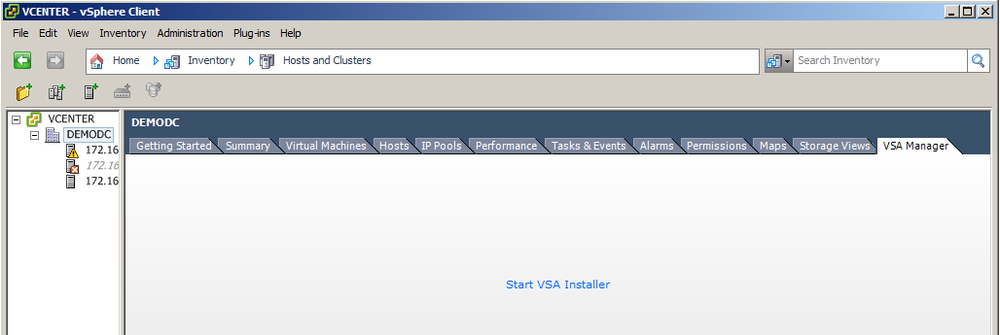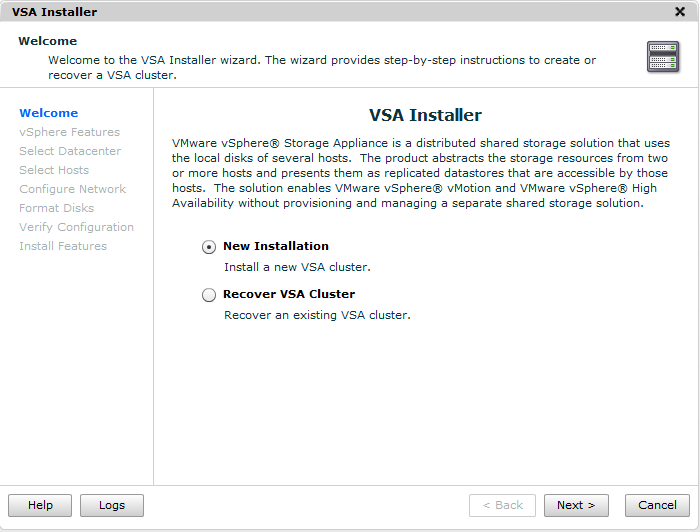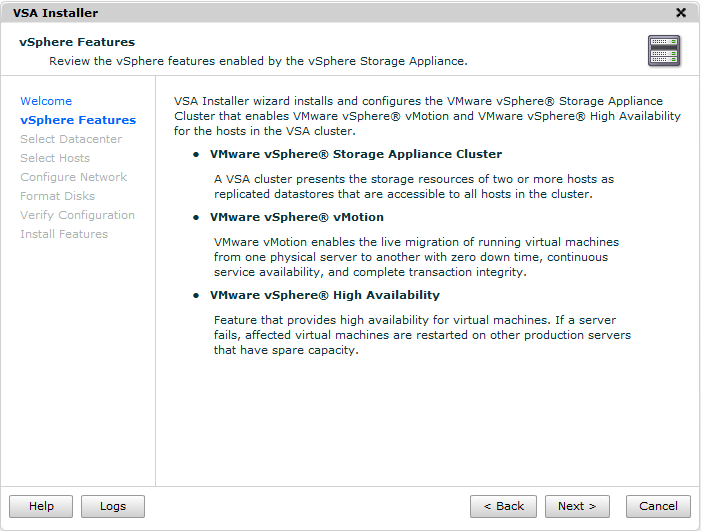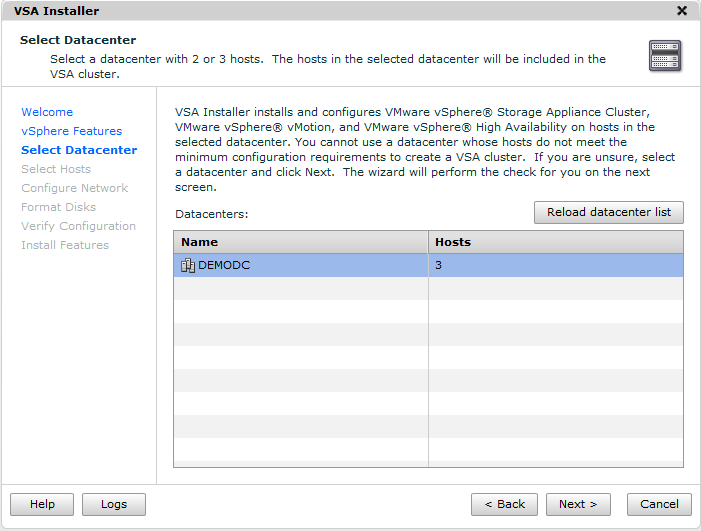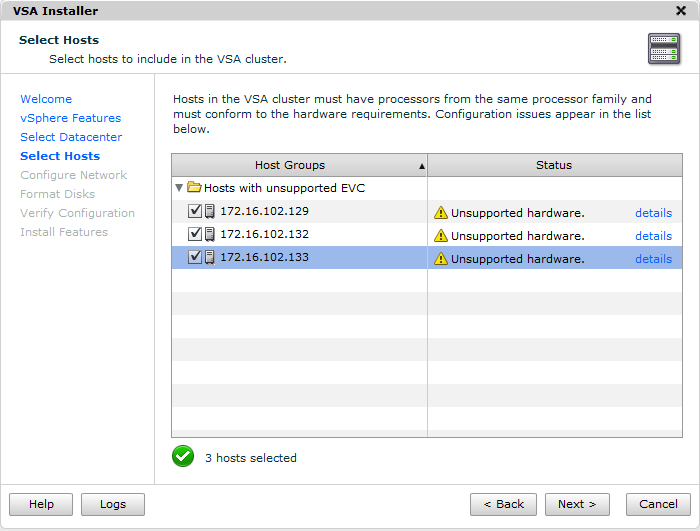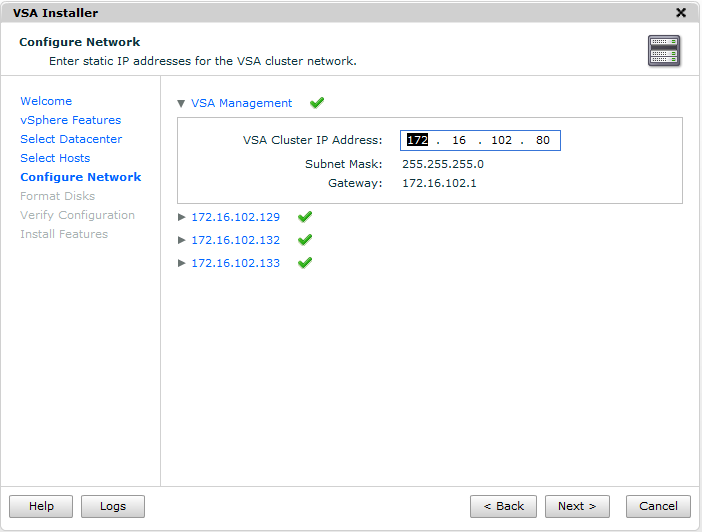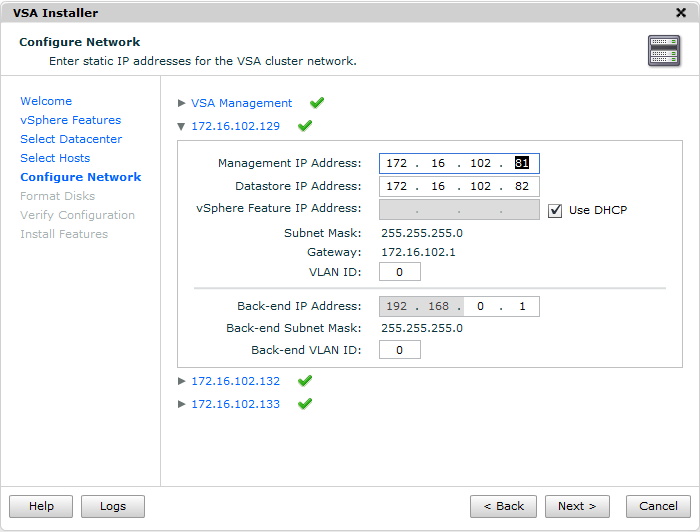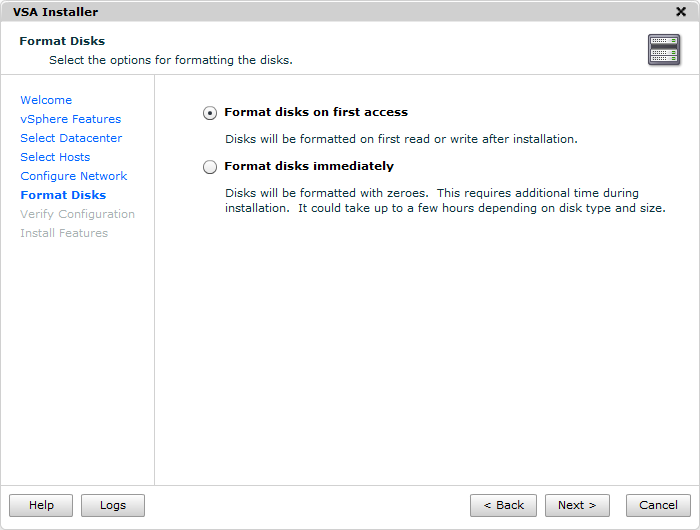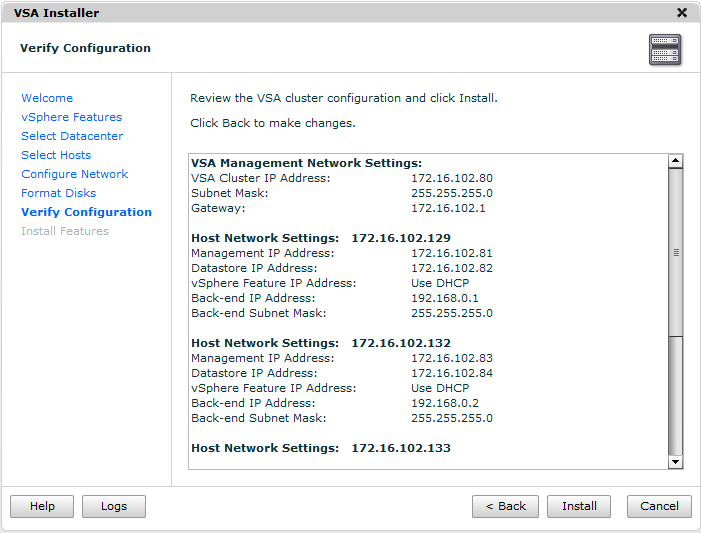Chapter 9. vSphere Storage Appliance
This chapter will discuss how to create a virtual SAN infrastructure that uses free and unused disk space on your ESXI servers. We will discuss the installation process, benefits, and limitations of the vSphere Storage Appliance.
9.1. What Is the vSphere Storage Appliance?
Problem
You wish to reclaim unused space on your ESXI servers and create a virtual SAN using the VMware Storage Appliance.
Solution
Deploy the vSphere Storage Appliance (VSA) on your vCenter server to create a VSA cluster and reclaim the disk space. The Discussion section discusses the benefits, features, and limitations of the VSA.
Discussion
The VSA is new in vSphere 5.0 and allows the SMB customer to use unused disk space on the ESXI servers and create a virtual SAN infrastructure to add more robustness to VMware’s already highly redundant platform. The VSA is a virtual appliance that combines SUSE Linux Enterprise Server 11 and storage clustering services. The VSA virtual machine can run on either two or three ESXi hosts to create a unified storage platform.
At the time of this writing, using a VSA Cluster allows:
Shared datastores for all ESXi hosts in the datacenter
One replica of each shared data store across ESXi hosts
vSphere vMotion and vSphere HA within the VSA cluster
Hardware and software failover capabilities
Replacement of a failed VSA cluster member
Recovery of an existing VSA cluster
The VSA cluster will keep a replica of each volume inside the VSA cluster on another member of the cluster. This creates a highly redundant platform, so that failures of the VSA appliance don’t entail massive amounts of downtime.
When building your VSA cluster, it’s important to understand its disk layout. Let’s take a look at the formulas that VMware has created to determine the amount of space available inside the VSA cluster.
VMware directly states: “VSA datastore capacity = hard disk capacity of an ESXi host / 4, Where hard disk capacity of an ESXi host = the total capacity of the hard disks that are installed internally on the ESXi host.” The following examples are provided directly from VMware:
Example: Cluster with 3 ESXi Hosts with 8TB hard disk capacity per host w/ RAID 10
Hard disk capacity per ESXi host = 8TB
Total hard disk capacity of all ESXi hosts = 24TB
VSA data store capacity = 8TB / 4 = 2TB
Total VSA cluster capacity = 2TB * 3 hosts = 6TB
Example: Cluster with 3 ESXi hosts with RAID 5 and 8 disks (if using RAID 6, you will subtract another -1 on the total storage capacity per host line)
Total storage capacity per host = (8-1) * 500GB = 3.5TB
Capacity of a VSA data store = 3.5TB/2 = 1.75TB
Total VSA cluster capacity = 1.75TB * 3 hosts = 5.25TB
These examples show that the replicas take up space.
It is possible to mix different drive sizes inside a VSA cluster. For example, if you have three ESXi hosts, two with 8TB and one with 6TB of space, ESXi will automatically take the lowest sized disk into consideration when calculating the space for the VSA cluster. It is important to keep this in mind so space is not wasted if it can be helped.
vSphere Storage Appliance Requirements
Solution
The Discussion section lays out the requirements and the limitations of the vSphere Storage Appliance.
Discussion
The vSphere Storage Appliance has some strict limitations in its current 1.0 version. Table 9-1 summarizes the basic requirements needed to create a VSA Cluster.
| vCenter Server | Hardware requirement |
| CPU (processor) | Either a single dual-core 64bit processor or dual single-core processors |
| Memory | 4GB minimum; increase to 8GB if you are running SQL on the same server |
| Disk (storage) | 4GB minimum; allow for growth |
| Microsoft SQL versions | Roughly 500MB will be required for a small database; our suggestion is 2GB to ensure room for growth |
| Networking | Either a single gigabit or dual gigabit Ethernet connections |
The ESXi Hosts in the VSA cluster must be configured identically. Additionally, the ESXi hosts must not be in a current HA cluster and cannot be running virtual machines. The VSA installer will create the networking and HA cluster when installing and configuring the VSA appliance (Table 9-2).
| ESXi Hosts (in a VSA Cluster) | Hardware requirement |
| CPU (processor) | Either a single dual core 64bit processor or dual single core processors; must be 2GHz or higher |
| Memory | 6GB minimum, 24GB recommended, and a maximum of 72GB has been tested with VSA 1.0 |
| Ethernet NICs | 4 NIC ports must be available on each ESXi Host |
| Hard drives | 2TB maximum capacity per hard disk with a 180GB limit per ESXi Host; disks must be all SATA or all SAS; they cannot be mixed; JBOD is not supported |
| Raid controllers | Any HCL supported RAID card in a 5, 6 or RAID 10 configuration |
| ESXi Hosts in VSA Cluster | A minimum of two ESXi Hosts per cluster with a maximum of 3 ESXi Hosts; you cannot add or remote ESXi Hosts to a VSA cluster once the cluster is created |
Supported OSs:
Windows Server 2003 Standard, Enterprise, or Datacenter 64-bit (SP2 required)
Windows Server 2003 R2 Standard, Enterprise, or Datacenter 64-bit (SP2 required)
Windows Server 2008 Standard, Enterprise, or Datacenter 64-bit
Windows Server 2008 Standard, Enterprise, or Datacenter 64-bit SP2
Windows Server 2008 Standard, Enterprise, or Datacenter 64-bit R2
Other required software:
vCenter Server 5.0
vCenter Server 5.0 Java Runtime Environment 1.6 (installed during vCenter Server 5.0 installation)
vCenter Server 5.0 Tomcat 6.0.18 (installed during vCenter Server 5.0 installation)
Windows Installer 4.5 or higher
Microsoft .NET Framework 3.5 SP1
Internet Explorer 7 or higher
Latest version of Adobe Flash for Internet Explorer
When determining the number of virtual machines that can run inside the VSA cluster, keep the following in mind. vSphere HA will reserve around 33% of the CPU and memory resources in a three-member VSA cluster and 50% in a two-member VSA cluster. Because you are virtualizing the storage, vSphere needs to ensure that enough resources are available for the VSA appliances to offer good performance inside the HA cluster. Adding additional resources to the ESXI servers will allow a larger number of virtual machines inside the cluster.
Installation of the vSphere Storage Appliance
Solution
Install the vSphere Storage Appliance within the vCenter.
Discussion
The vSphere Storage Appliance can be downloaded from VMware’s website. The installation is straightforward and should be performed on either the vCenter server or another Windows Server inside the network with access to the vCenter server. After installation, there will be a new plug-in added to vCenter that you will need to enable. Enabling it will then create a new tab on the datacenter inside the vCenter server.
Download the vSphere Storage Appliance from the VMware site. The appliance is going to be installed on your vCenter 5 Server. Double-click to launch the installation. Select the Language and click OK.
The vSphere Storage Appliance Installation Wizard starts. Accept the EULA and click Next.
The IP address and HTTPS port will be pre-filled if you are installing on the vCenter server (Figure 9-1). Otherwise, type in the IP address and HTTPS port of your vCenter server. Click Next.
Enter your vSphere Storage Appliance license key, or leave it empty to install in evaluation mode (Figure 9-2). Click Next.
Click Next Install to begin the installation (Figure 9-3).
Once the installation completes, click Finish.
Next, log in to your vCenter server and click Plug-ins followed by Manage Plug-ins. The VSA Manager should be enabled (Figure 9-4). If it’s not enabled, enable it now.
vSphere Storage Appliance Cluster Creation Process
Problem
After installing the vSphere Storage Appliance, you need to configure your datacenters and hosts.
Solution
Following the simple steps in the configuration, you can enable the VSA.
Discussion
In Installation of the vSphere Storage Appliance, we installed the Storage Appliance Manager and enabled the plug-in inside the vCenter server. We can go ahead and build our configuration and VSA cluster at this time, assuming we meet the requirements in vSphere Storage Appliance Requirements.
Open the vCenter, navigate to your datacenter, and click the VSA Manager tab. Click the Start VSA Installer link as shown in Figure 9-5. You will need to make sure you have Adobe Flash player installed on your server, because this tool requires it.
Next, you will see there are two options on the VSA Installer screen (Figure 9-6). Most of the time you will use New Installation. The other option, Recover VSA Cluster, should be used after you reinstall the vCenter from scratch or replace it without a migration.
- New installation
This will install a new VSA cluster on the ESXi hosts you select during the installation process.
- Recover the VSA Cluster
This will restore the VSA information and configuration back into the vCenter. This process will rescan the ESXi hosts for the VSA configurations and import them back into the cluster.
A summary of the VSA Install Wizard appears and will give you a overview of the installation process (Figure 9-7). Click Next to continue the installation.
Next, select the datacenter where you wish to install the VSA cluster (Figure 9-8). If you have more than one datacenter, you must choose one to hold the VSA cluster. Click Next.
Select the hosts to use for the VSA virtual machine (Figure 9-9). The status section will provide additional details that show you any issues regarding the configuration or provide information if that host doesn’t meet the compatibility requirements of the VSA cluster. Once the hosts are selected click Next to continue the installation process.
Enter the IP information for the VSA management network (Figure 9-10). This should be an IP address within the subnet where your ESXi Hosts reside. If you are configuring your VSA cluster with only two hosts, you will be required to enter another IP address. Once you enter the first IP address, the installer will autopopulate the additional IP addresses in sequential order, for example, 172.16.102.80, 172.16.102.81, etc. Click Next to continue the installation.
Click the other ESXi Hosts and make sure their networking is correctly configured (Figure 9-11). The vSphere Feature IP address can be left to use DHCP if you choose. If unchecked, it will autopopulate with an IP address from the same subnet as the VSA Cluster IP address. Additionally, any VLAN information can be configured here as well.
Click Next to continue the installation.
The installation now asks how you want to format your storage (Figure 9-12). If you can, select the format the disks immediately option, this will save time and overhead on the ESXi hosts. However, if you wish to wait, you can select the Format disks on first access and they will be formatted later.
Click Next to continue the installation.
Review the summary of the installation and click Install (Figure 9-13).
Once the installation starts, you will be prompted to accept the notice warning that the disks being used will be formatted and the content will be erased (Figure 9-14). Click Yes to accept and the installation will continue.
The installer will begin creating the cluster and moving your ESXi Hosts into the new cluster as well as configuring the networking aspects of the VSA cluster (Figure 9-15). The time this takes can vary depending on the configuration and how you choose to format your disks. Any errors will be noted at the end.
After the installer completes successfully, you will have access to the storage on the VSA Cluster immediately. Please see Recipe 9.1 for additional information and limitations on the vSphere Storage Appliance.

